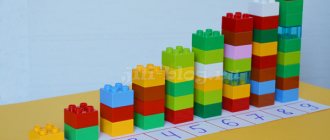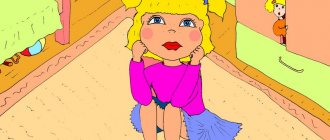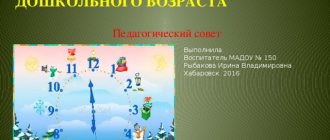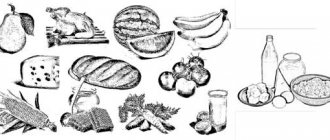Distinguish between "left" and "right"
For studying in general and so as not to confuse the concepts of “clockwise” and “counterclockwise” as well.
Have a general understanding of time
We explain to the child the concepts of “yesterday”, “today”, “tomorrow”; "past present Future"; “morning”, “day”, “evening”, “night”, “day”. Often children themselves associate time with a specific event: “in the morning I did exercises”, “at lunch I ate soup”, “before going to bed I brushed my teeth”, etc. Therefore, when explaining the above concepts, it is best for a parent to tie specific events to them.
Correct your child carefully if he makes mistakes somewhere. It is important that he does not develop a false understanding of time.
Have you successfully completed the preparatory stage? Now we can teach the child to understand time using a clock with arrows.
Why do you need to teach your child to tell time?
Imagine that you cannot navigate time at all. You don't know when you need to go to work, when to return home, when it's lunch, or what time you go to bed and wake up. Also, your baby does not understand how long it takes for his mother to pick him up from kindergarten. He may be capricious if you tell him to wait five minutes, because he does not understand how long it is, he may have to wait all day. If the baby has grown to the age when he can be left alone at home, you tell him that you will return in two hours, and without the ability to tell the time by a dial, the child will be confused, he will not know how long his mother will not be around. In order for your baby to be able to navigate all these things, and also be more disciplined, as well as ready for school, he needs to be taught how to tell time using a clock.
Why do you need a watch?
Why do we need a clock? What do you think would happen if no one had a watch? If it is difficult for a child to answer a question, start thinking out loud yourself - fantasize (Here is what children can answer: “Dad wouldn’t know when to go to work”, “We would go to Misha’s birthday, but wouldn’t know the time. Come - and there’s no one there anymore. And we’d be upset,” “We’d go to the toy store, but it’s closed,” “We’d be late everywhere,” “We could miss the train or plane”)
How do you think people used to live without watches? How did people determine time? (Give your child the opportunity to think, think for yourself. After all, there was a time when there were no clocks. How did people get by without them?)
It turns out that there were clocks before, but in those ancient times they were different -... alive!!! Guess what a “live clock” is? What could they be? After asking a question, always pause to think and answer. If your baby is shy or at a loss, start thinking out loud and asking yourself questions. The child will gradually listen to you and reason with you. And then he will join the discussion and express his opinion. Let the child express the most fantastic assumptions, encourage him for them - he thinks and he expresses HIS OPINION, and this is VERY VALUABLE! It is much easier to retell someone else’s opinion to a preschool child than to have your own and express it in words. And in our modern life, the ability to formulate one’s point of view is the basis for success in many matters. After your child has dreamed up his imagination, tell him about a real live clock.
How to motivate your child to quickly learn to recognize the time on the clock
Of course, for successful learning, the preschooler himself must be interested in understanding the structure of a clock with hands. Motivation could be as follows:
- Tell your child that a person simply needs a watch in order not to be late for anything, and to manage his time.
- Pay more attention to time intervals: “Now I’ll finish my business, and in 15 minutes we’ll go for a walk,” “You’ll go to bed at 9 o’clock, but in the meantime you can play,” etc.
- Hang an original clock in the child’s room that attracts his attention, and invite him to learn to understand it.
- An original wall clock will definitely attract the attention of a child.
- Buy an hourglass and experimentally show your son or daughter how time “runs away.” Then tell that time needs to be valued, show that there are other clocks that will help determine exactly how much time has passed.
- Before introducing your baby to clocks with hands, you can show him sand clocks.
- Buy your child a beautiful wristwatch. This will be an incentive to learn how to tell time, because this accessory is not interesting to wear simply as decoration.
Time-telling tasks for kids
To consolidate the results obtained and check, the baby is offered to play games. You can remove the wall clock and set a specific time. For example, 10:40, and the baby must say what time it is. The arrows can be moved until he begins to identify numbers more confidently, but it is important not to tire the child. You can play the game in reverse: the adult calls the time, and the baby sets it on the dial.
For the next task, you will need two dials on which you need to set different times (for example, 12:15 and 3:40). The parent shows the dial to the baby and asks what he usually does at this time (has lunch, walks, sleeps).
During the learning process, it is important to be patient and accept failures calmly. It is better to once again praise the baby for his successes, and repeat what is poorly remembered several more times.
Where to begin
In a child’s understanding, time is a complex, non-existent concept; it cannot be touched or tasted. The baby understands that everything around him is changing, but he cannot measure or feel the changes.
The first thing you should start getting acquainted with is the basic division of time into the future, present and past. Use simple examples to explain these concepts to your child:
- Future: in the evening we will go for a walk.
- Present: We are playing now.
- Past: in the morning we had breakfast.
Explain the difference between them using clear and interesting words and examples.
Let’s start with the very concept of time: how to navigate it, what a day is
As has already been said, before introducing a child to a clock with hands, it is necessary for him to understand the very concept of time (this can be done long before lessons with a clock, as early as 3–4 years old). The difficulty is that time is abstract; it cannot be seen or touched with your hands. Information should be divided into specific blocks.
- Time does not stand still, it moves all the time, “flows ”. There is the past - what has already happened and will never return, the present - one moment that is happening now, the future - events that are yet to come. It is necessary to give specific examples: “This morning you walked in the yard, now we are talking, and in the evening we will have a delicious dinner.” It is also useful to look at a photo album (“Look how small you were and what you have become”). You should definitely use didactic materials, for example, the game “First and Then”. The child is offered pictures of objects and objects, and then other cards depicting what happened to them over time. The preschooler's task is to make pairs of cards.
Such material will help the child feel that time does not stand still, but moves all the time.
- There are seasons that follow each other. This is quite easy for a child to understand. The explanation is again supported by clarity. It should also be mentioned that the year is divided into months, the month into weeks, and each week has 7 days.
Usually children easily understand what the seasons are
- The key concept in this case will be parts of the day. The child must learn that the day is divided into 4 parts. In total they last 24 hours. Pictures, as well as associations (“In the morning you go to kindergarten”, “In the evening you go to bed”) will again help you remember the concepts of “morning”, “day”, “evening”, “night”. You can navigate by the sun: in the morning it just rises above the horizon, during the day it is high in the sky, in the evening it descends again, at night the sun disappears, but the moon is visible in the sky).
The key concept for learning will be parts of the day
Questions and tasks:
- What is a clock?
- What antique watches do you know?
- What types of watches are you familiar with?
- What types of clocks are considered household clocks?
- What watches are considered street watches? How are they different from home ones?
- Tell us about the Kremlin chimes.
- What “natural” clocks do you know?
T.A. Shorygin "Conversations about space and time." Toolkit
Source
Series of messages “The world around us”:
Part 1 - Mysterious kingdom, forest state.” Summary of a lesson on cognitive and speech development of children Part 2 - Knowledge of the world around us and the development of creative abilities in children ... Part 4 - Formation of a child's ideas about time Part 5 - Lessons on the topic Winter from the site CHILD DEVELOPMENT Part 6 - History of clocks for children. Conversations about time. Part 7 - What are hour hands. Conversations about time. Part 8 - What is a day? Conversations about time. ... Part 30 - SEASONS. Let's learn to write a story. Part 31 - Seasons and months for children. Part 32 - Business card poems for Winter, Spring, Summer and Autumn costumes
Concept of time
In the early stages, you can invite your child to play such games.
- "Day and night". The ability to distinguish between daytime and nighttime is being developed. As a rule, the activity does not cause difficulties.
- "When it happens." The child is given a specific situation (for example, children go to kindergarten). He needs to determine whether it occurs during the day or at night.
- "Parts of the day." The task is aimed at developing the concepts of “morning”, “day”, “evening”, “night” and distinguishing them. First, the parent, asking leading questions, helps the child answer what happens in the morning (children get up, go to wash, go to kindergarten, and so on). Then he consolidates the acquired knowledge, inviting the child to independently list the signs of morning - not only the actions of the child himself, but changes in the world around him (it becomes light, the sun appears).
After such classes, the child should understand the following concepts:
- day;
- parts of the day - morning, afternoon, evening, night.
When the baby understands what a day is and that every day is divided into 4 parts, you can begin the next stage of learning.
When to teach your child to tell time
The child should be introduced to the basic division into the future, past, present, seasons of the year and day as early as possible. Two- to three-year-old children can easily navigate the concepts of day and night, winter and summer, as well as today and tomorrow. Parents should teach their baby to name the 12 months and seasons.
To teach a child to tell time using a clock, the baby must grow up a little. Experts consider the optimal age to be 5-6 years, because the child will subsequently need this skill at school.
What a child must be able to do to correctly tell time using a clock
What a child must be able to do in order to correctly tell time using a clock:
1. Count from 1 to 100.
Let the child write numbers from 1 to 60 on a piece of paper. While writing, let him say it out loud.
- If this skill has not yet been practiced, hang this piece of paper in a visible place and have your child repeat it regularly.
- Whenever possible, show your baby single and double digit numbers and ask them to name them correctly.
- Be sure to praise and encourage them for success.
2. Count by fives.
Let the child write the numbers, preferably while saying them: 5, 10, 15, 20, 25, 30, 35, 40, 45, 50, 55, 60.
- Compose a song “Counting by fives” for any motive. The main thing is that it is easy to remember. You can add clapping, stomping, jumping, etc. to the song. For example, for all numbers ending in 5 we squat, for all numbers ending in 0 we stand up.
- Sing this song regularly so that your child learns to count by fives forward and backward.
3. Have a general understanding of time.
The child must understand the meaning of the concepts “morning”, “day”, “evening”, “night”.
- Let the child come up with and say what associations he has with each time of day.
- Make sure your child understands that after night comes morning, then day, etc.
- You can ask: “What do we do in the morning?”, “What happens in the evening?”, “What will you do at night?” and so on.
4. Visually recognize numbers from 1 to 12, be able to write them.
5. Know what “before”, “after”, “quarter”, “half” are.
If your child already knows and can do all this, you can safely explain to him the time on the clock.
Getting to know the dial and hands
It is easier to introduce a child to the dial on a toy watch. They can be flat or more voluminous. The main thing is that the numbers are clearly visible and the arrows rotate easily.
It is better to teach your child not on a real watch, but on a toy one, where the numbers are clearly visible and the hands rotate easily.
You can make such a thing yourself from ordinary cardboard or a disposable plate.
You can make a training clock yourself
You need to tell your child that the surface of the watch is called the dial. It can be compared to a pie or an orange: it can be mentally divided into pieces or slices. There are two hands on the dial: a shorter one (it shows the hours) and a longer one (it shows the minutes).
It is necessary to briefly mention the second hand and tell you that it is not found on all watches. This is an arrow that moves very quickly, because a second is a very short unit of time, it is literally one moment.
Next, the adult explains that although there are 24 hours in a day, only 12 digits are reflected on the dial. The thing is that during the day the hour hand (short) goes around the circle twice.
We learn to determine the clock on a simulator with a small hand
First, you should focus the child’s attention on the movement of the hour hand (we don’t touch the minute hand yet). For example, we put the short hand on o and explain to the baby that the clock shows 2 o’clock (if the design of a toy clock allows, the minute hand can be removed for now).
Then the preschooler is asked to set the time himself, which the adult will tell him.
First, let your baby learn to tell the exact time (hours only, no minutes)
Let's move on to minutes
Then the minute hand joins the teaching. First, it is best to explain to a preschooler the concept of “half an hour” - when the long hand is on o (at the same time “30”). You can compare it to half the pie.
After this, we move on to the concept of “15 minutes” (the number “3” on the dial, or a quarter of the pie).
At first it’s easier to show what half an hour and 15 minutes are
After this, we move on to the remaining minute intervals - we show the child all the possible options and invite him to independently set one or another according to the instructions of the adult.
Let the preschooler show a variety of time intervals in minutes on the clock
It may be a little difficult at first, but repeated repetitions will do the trick. In addition, to make it easier to count large intervals, you can first divide them into two parts: 30 minutes and 10 minutes - this turns out to be 40 minutes.
Then you should tell the child that the minute hand can stand not only on a mark that is a multiple of five, but also on other divisions (for example, it can show 6, 14, 27 minutes, etc. You need to draw the child’s attention to the fact that these divisions most often are not signed, but simply marked with short segments or dots to avoid cluttering the dial.
Please note that the arrow may not always point to a multiple of five.
It's also worth noting that adults sometimes round up time. For example, if the minute hand shows 29 minutes, then they often say “it’s 30 minutes now,” etc.
Learning through drawing
Children perceive information better while playing, so you can draw and cut out a homemade clock with arrows together. To begin, cut out a circle from cardboard and draw a dial on it. They give the child the opportunity to color it to their liking and apply the numbers in bright colors. Two hands (hour and minute) are drawn on cardboard, cut out and attached to the dial so that they can move in a circle.
A bolt or button works perfectly as a fastener.
To get acquainted with the quarter dial, the homemade mechanism is divided into sections of 15 minutes each. In each section you need to count the number of lines. You can draw colorful pieces of pie on the dial, each piece of which equals 15 minutes. To study the half hour, the dial is divided into two equal halves and shaded with different strokes. The parent explains that there are two equal halves of 30 minutes in an hour.
We combine hours and minutes and teach how to tell the time on a watch
When the baby learns to separately show the given hours and minutes on the dial, you can combine these units. Again, first the adult shows various examples, for example, 2 hours 15 minutes. Then the preschooler starts training.
There is one caveat here. The child must learn that when the minute hand moves, the hour hand moves a little. For example, if the time is 5 hours 30 minutes, then the hour hand will not be on o, o in the middle between “5” and “6” (After all, it is not exactly 5 o’clock, but a certain time has passed).
The child must understand that when the minute hand moves, the hour hand also moves slowly.
How to clearly explain “day” and “night” time
And the last stage of teaching is to explain to the child that there is “night” and “day” time (we already told him earlier that there are 24 hours in a day, and the hour hand goes around the dial twice during this time).
The best way to deal with this complexity is to use a special simulator that you can easily make with your own hands:
1. You need to cut out two cardboard circles of the same size, but different colors. The first one will be “daytime”, numbers from 1 to 12 are written on it. The second one, accordingly, will be “nighttime” (numbers from 13 to 24). Small cuts are made on the first dial so that the number can be slightly bent. Arrows are also made.
You need to cut out two dials of different colors and sign different numbers on them
2. The dials are fastened together (they are fixed by arrows). At the top is the “day” part. Then we show the child, for example, 4 o’clock in the morning and show which “night” number corresponds to this (it will be 16 o’clock).
3. It should be understood that the division into “night” and “day” time is quite arbitrary. After all, 2 hours is, in fact, night, not day, and 15 hours is day, not night. The child just needs to understand that when we say, for example, 19 o’clock, then it is evening, but the hour hand will point to the number 7, etc. And he can practice this on the specified simulator.
Teaching time and consolidating material in a playful way
As you know, children perceive information best in a playful way, so parents should take care to create an interesting and fun learning process.
Using the constructor
You can purchase a special kit in the store, which includes a wooden construction set and a notebook with assignments. Thanks to the additional developmental materials that are in the notebook, the baby will not only master the dial, but also prepare for school.
The wooden construction set is a dial with numbers from 1 to 12 and from 1 to 24. The minutes and seconds are marked on the construction set, and there are also movable hands with which the baby can set the time. The constructor can be colored as you wish.
The child assembles such a construction set independently, which will initially help to interest him in the game.
Interesting online games
Today, many children tell time only by electronic mechanisms, because it is much easier. The online game “Learn Time” helps you understand what time a mechanical watch shows. The game invites you to look at an electronic watch and, among the proposed mechanical options, find one that shows the same numbers. After confirming the choice, the baby moves on to the next task.
The educational online game “Watches – Studying Time” introduces the young player to mechanical and electronic mechanisms.
The game is designed for children from 3 to 5 years old. Here you can see a mechanical clock in the shape of a house where a cuckoo lives. There is an electronic clock in the right corner of the screen. First, they determine the time on a mechanical clock, and then set it on an electronic clock. The baby needs to follow the view from the window in order to correctly determine the time of day.
Games to consolidate results
Reinforce your learning with simple practical tasks in a playful way. When performing a certain action: going to bed, waking up, setting the table for dinner, ask your child to watch and tell you what time the clock shows.
When turning on cartoons, a computer game, going on a visit or for a walk, clearly state the planned time interval: 15 minutes, half an hour, an hour - and pay attention to the location of the arrows.
Ask your child for help when doing household chores, for example, ask him to remind you to turn off the stove in 5 minutes, say that it’s time for dinner if the big arrow is on the number 6. Teach punctuality: when going somewhere, talk about the time for getting ready and traveling .
Here are some ways to master time categories playfully:
- " Tell me what time it is ." Set the time on the layout. Take a teddy bear, tell your baby that he is in a hurry to get home and asks what time it is. The kid must answer, if he can’t, help him.
- Make the exercise more difficult by changing the position of the hands on the dial. Repeat several times to consolidate the result.
- " Make a daily routine ." Take the clock model in your hands. Set the arrows to the time when the baby usually wakes up, then, moving their progress, discuss all the actions that he performs during the day, in the morning, at lunch and in the evening.
- " True False ". Place arrows on the layout, ask the child if it is correct that it is such and such a time. He must confirm or refute what was said. If he is in difficulty, ask leading questions.
- " Schedule ". Invite your child to start playing bus station. To dispatch the cars, he himself needs to set the clock hands to the specified time. Use whole numbers first, then complicate the task by using definitions such as “noon”, “quarter of an hour”.
"Cubes"
To play you will need 4 dice and our homemade clock. We throw the dice in pairs. The first pair of cubes will determine the hours, the second pair will determine the minutes. The time that has fallen must be set on a toy watch.
There are also interactive games with clocks on the LogicLike platform. We have more than 3,500 exciting tasks for children of preschool and primary school age that help develop logic, thinking, and memory.
Poems about time for children
It is very good to use short poems during the learning process to remember the basics of time. This will make it more fun and easier for the child to immerse himself in the process of learning this concept.
Here are the funniest and most interesting poems.
Hours and minutes will pass, They will gather together in a day. They have twenty-four hours, and the hands work wonders.
The arrow passes the first circle, - Noon comes to visit us, And she hurries again to mark hour after hour.
The arrow has passed the second circle, - Midnight came to visit us, The day passed, and the night passed, - They ran away for a day.
***
The seconds are counting, the Dwarf has taken the lead, but he doesn’t know yet how short a second is.
Look at the clock - The hands are not here for show: They indicated for us the Second, the minute and the hour.
A second is a thin one, A minute is a long one, And a short one is an hour: This happens every time.
Sixty seconds have passed - We have approached the minute. Well, sixty minutes together will give you a whole hour.
***
The walkers suddenly began. What happened, what happened? The arrows immediately stopped winding Day around the axle. The gray-eyed dial looked at them gloomily: “If you are not to blame, is someone still to blame?” “Maybe,” thought Roma, “the pendulum has no strength, try with your head down. Swing for so many years!”
***
There is a clock on the wall in the room. It is not hanging for decoration. And to the rhythm of knocking: tick-tock, tick-tock. Everyone is given a conventional sign. Day and night change outside the window. The dawn is wonderful. And then for a person all year round, the time has come for daytime worries.
Watch another interesting video about teaching time to children.
A child should be taught to value time and use it wisely from childhood. Ask him what good, useful or enjoyable can be done in an hour, a minute, half an hour. Don’t expect quick results, don’t rush the learning process: time orientation is a complex skill.
The smaller the child, the shorter the lesson should be. So that he quickly learns to understand complex concepts, learn to understand the movement of the mechanism, find out what time it is, buy him a bright wristwatch. This way the child will quickly begin to use the acquired knowledge in practice.
Listen to the poem "The Cuckoo Clock."
The Merry Cuckoo lives in a carved hut. She crows every hour and early in the morning she wakes us up: “Cuckoo! Cuckoo! It's seven in the morning! Cuckoo! Cuckoo! It's time to get up!" The cuckoo lives not in the forests, but in our old clocks!
There are also clocks on city streets and squares. They are installed on towers, station buildings, theaters and cinemas.
The most famous clock in Russia is the Kremlin chimes, installed on the Spasskaya Tower of the Moscow Kremlin.
The first clock on the Spasskaya Tower appeared at the beginning of the 17th century. They were created by the English master Christopher Galovey. For his work, he received a royal gift - a silver cup and, in addition to it, satin, sable and marten fur.
After some time, Russian Tsar Peter I ordered another watch from Holland. At first they were transported by ship by sea, then delivered on 30 carts to the Kremlin.
Master Galovey's old watch was removed and replaced with a Dutch watch. When this clock also became dilapidated, another large chiming clock was installed in its place, which was kept in the Armory Chamber.
For several centuries, the Kremlin's Spasskaya Tower has been decorated with clocks. A whole team of experienced watchmakers maintains their work, making sure that the watches do not lag behind and are not in a hurry. There are 117 stone steps leading to the chimes. Behind them begin the cast-iron steps of a spiral staircase leading to the eighth floor. The chiming mechanism is located here.
“The iron colossus is all shiny, oiled. The polished copper disks of the dials shine, the levers are painted red, and the gilded disk of the pendulum, similar to the circle of the sun, shines. He reigns over this system of shafts, cables, gears, forming a complex timekeeping mechanism” (L. Kolodny).
On December 31, with the first strike of the Kremlin chimes, the country enters the New Year. Having heard the chime of the famous clock, we wish each other happiness and congratulate each other on the New Year!
The watches that modern people use are mechanical. Then they need to be started at certain intervals.
Mechanical watches were invented in the 17th century. scientist Christian Huygens, since then they have served us faithfully.
In the second decade of the 20th century. Electronic and quartz watches appeared. They run on batteries or mains power.
And the most accurate clocks are atomic ones.
Do you know what watches are called natural or living?
In the old days, such a living clock in the village was, of course, Petya the Cockerel. The peasants noticed that the rooster crowed for the first time at about two o'clock in the morning, and the second time at about four o'clock in the morning.











